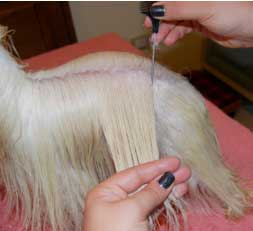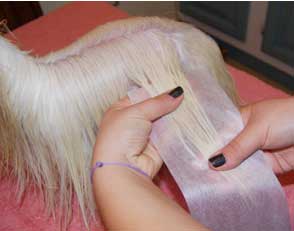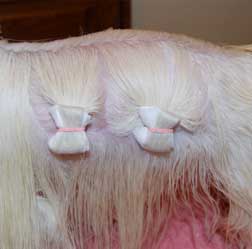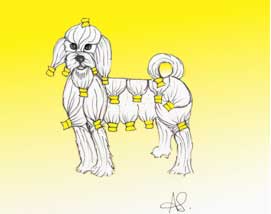
IT

EN
TOLETTATURA
Alla base della tolettatura di un Maltese deve esserci un mantello con il pelo di buona tessitura, liscio e con una buona crescita, che non sia particolarmente fragile. Mantelli di scarsa qualità rendono la tolettatura del Maltese molto difficile.
Gli angoli dei follicoli piliferi del Maltese sono perpendicolari al corpo e questo fa sì che il pelo cada naturalmente verso il basso. Il pelo si allunga per tutto i periodo in cui la cellula germinale del bulbo pilifero è attiva; seguirà un periodo di stasi e poi di atrofia che provocherà la caduta del pelo. A questo punto il bulbo pilifero si rigenera e si sviluppa un nuovo pelo. Il ciclo del pelo del Maltese somiglia a quello dei nostri capelli. Il pelo liscio visto in sezione trasversale è rotondo.
Le ghiandole sebacee secernono un olio naturale detto sebo che protegge la cute ed il pelo. L’aggiunta di olii artificiali e balsami aiuta a mantenere il pelo in buone condizioni quando esso è molto lungo. Una corretta presenza nella dieta del Maltese di proteine, grassi e vitamine aiuta una buona crescita del pelo.
SHAMPOO
Lo shampoo è composto da una parte alcalina e da una parte oleosa o grassa. Il pH dello shampoo non deve essere alto, altrimenti rende il pelo secco e fragile; il valore corretto deve essere intorno a 5, per questo gli shampoo per uso umano non sono adatti per la tolettatura di un Maltese, avendo un pH intorno a 7.
Il bagno può essere fatto ogni volta che è necessario, con uno shampoo per manti lunghi. Se il pelo non è molto sporco, solitamente è sufficiente un solo shampoo. Dopo l’applicazione del prodotto risciacquare accuratamente tutto il pelo.
La durezza dell’acqua incide molto sul risultato dello shampoo: un’acqua dolca lascerà il pelo molto più morbido.
BALSAMO
Dopo lo shampoo il pelo del Maltese richiede l’applicazione di un balsamo che va utilizzato dopo aver tolto l’acqua in eccesso dal pelo con un asciugamano.
Il balsamo viene lasciato in posa per alcuni minuti e poi risciacquato. Perché il balsamo sia distribuito bene su tutto il pelo, va diluito in una giusta quantità di acqua e poi distribuito sul mantello, quindi si procede all’asciugatura con un phon a temperatura non troppo calda, facendo prima un lato e poi l’altro, a partire dalla parte posteriore.
CURA GIORNALIERA
Il Maltese andrebbe spazzolato e pettinato almeno a giorni alterni in ogni sua parte, partendo dalla zona posteriore (si potrebbero mettere foto di spazzole e pettini) , prima da un lato, poi dall’altro, quindi si passerà alla testa. Il colpo di spazzola va dato dalla base del pelo alla punta, senza sollevare la ciocca. La divisione del pelo va fatta dalla punta del naso, sul cranio verso l’occipite, si procede lungo il collo e il dorso, fino alla radice della coda.
A tale scopo è bene utilizzare un pettine a coda. Per evitare che le lacrime macchino il pelo, gli occhi andranno puliti giornalmente con appositi prodotti. Oggi sono in commercio anche prodotti per uso orale, finalizzati al controllo della lacrimazione e alla riduzione delle indesiderate macchie sotto gli occhi. E’ bene evitare che il pelo cada negli occhi, provvedendo a legarlo in maniera corretta. IL MALTESE DA ESPOSIZIONE richiede l’impacchettamento del pelo come si vede dalla foto.
Come in tutti i cani dalle orecchie pendenti, va curata la pulizia del canale uditivo, utilizzando periodicamente prodotti idonei. Si dovrà prestare particolare attenzione anche all’igiene dentaria, con periodiche pulizie eseguite da un veterinario.
Consigli per la tolettatura da esposizione
Per coloro che volessero provare a cimentarsi ad avere un Maltese da esposizione, sarà bene iniziare a dire che il suo pelo dovrà essere molto curato e la sua lunghezza dovrà toccare terra. Per non farlo sciupare occorrerà sia nutrirlo con oli e balsamo, sia fare dei pacchetti in modo che il cane, strofinandosi per terra o nella sua cuccia, non possa spezzarlo. Ecco qui i consigli base.
Prima di mettere in vasca il vostro maltese dovrete aver spazzolato bene il suo pelo, in modo che non ci siano nodi o infeltrimenti.
GROOMING
A good start for a good grooming of the Maltese is a well textured and strong coat, smooth and with enough growth. Low quality coats make grooming the Maltese a very difficult job.
Hair grows perpendicular to the skin of the Maltese, thus the fur naturally points downwards. Hair will grow constantly during the life cycle of the germinal cell of the follicle; afterwards, a non-growing phase will anticipate its atrophy and the shedding. At this stage the follicle regenerates and a new hair will start growing. The smooth hair, typical of the Maltese, has a round section. The growth cycle of the Maltese coat is very similar to the human hair.<br>
The sebaceous glands produce natural oil called “sebum”, which protects the skin and hair. Using oils and conditioners help maintaining the coat in good condition when very long. Also, a correct balance of nutrients in the Maltese diet favours a good hair growth.<br>
SHAMPOO
Shampoos are made part alkaline and part oily-based. Its pH should not be high since this would make hair thin and fragile. The correct pH should be around 5: human shampoos are not correct as their pH is 7.
Washing can be done every time it is deemed necessary by using a shampoo specifically formulated for long coats. If not too soiled one shampoo is enough. Always rinse thoroughly after shampooing. Water hardness has an effect on the final result: soft water will leave the coat smoother.
CONDITIONER
After shampooing and after removing the excess moisture with a towel, it is necessary to use a conditioner/moisturiser, which needs to be left on the hair for a few minutes and then rinsed off. Make sure the moisturiser is evenly distributed: diluting it in water before applying it is very helpful. Afterwards, using a mildly warm hair dryer, proceed from the tail backwards on both sides.
DAILY CARE
Brushing of the Maltese should be carried out at least every other day, starting from the back, working each side at a time, and starting brushing from the base of the hair toward the tip.
The central split in the hair is started from the head then extended along the neck, the back until the inception of the tail. To help you in this task try using a tail comb.
To avoid tears staining the fur, clean the eyes daily with specific products. There are also tablets specifically formulated for reducing lachrymation.
It is good practice to prevent hair falling into the eyes by tying it.
Show maltese requires hair preparation as in the photo
As for every dog with ears pointing down, it is essential to carry out regular care of the ear canal. Also, dental care requires constant care that can be carried out by a vet.
SHOW GROOMING ADVICE
For those who would like to have a show Maltese, here is some information to help you out. The coat will need to be perfectly groomed and extend all the way to the ground. To avoid it from being damaged, it is necessary to use oils and conditioners and collect the hair in small “packets” to prevent it from being worn by the dog either rubbing on the ground or lying in their basket. Here is some basic information.Before bathing your Maltese, always brush its coat thoroughly.

Dopo aver lavato bene il pelo del cane, in modo dolce da non infrenarlo, e risciacquato, andrete a mettere un buon balsamo nutriente. Alcuni, come suddetto, aggiungono degli oli appositi per dare ancora più nutrimento al pelo, altri no, dipende molto anche dalla qualità di pelo del soggetto che avete. Le foto che vedrete sono di un Maltese al quale è stato applicato balsamo e olio, per questo vedrete il pelo che sembra un po’ giallastro.
Una volta applicato il balsamo in modo uniforme e facendolo penetrare bene nel pelo pettinandolo nella sua lunghezza e lasciandolo agire per almeno 3/4 minuti, non lo sciacquerete , ma toglierete l’acqua in eccesso solo strizzando delicatamente le parti lunghe del pelo, le zampe e la coda.
After gentle washing and rinsing, working with care to avoid ruffling the fur, apply a good quality oil or moisturiser.
Some owners use specific oils, which enhance the fur by deeply nourishing it.
The photos below show a Maltese after been moisturised with specific oil, thus the slight yellow hue. After leaving the moisturiser on the wet fur for 3 to 4 minutes, do not rinse but only remove excess water from the longest parts of the coat, the paws and the tail.

Tamponate il pelo del cane avendo cura di non arruffarlo.
Prima di passare all’asciugatura col phon, pettinate bene tutto il pelo con un pettine a denti larghi, dalla testa alla coda, zampe comprese, in modo da essere certi che non ci sia la presenza di nodi.
Do not ruffle up the coat, only pat it gently.
Before drying it, comb the coat with a wide-toothed comb, working form the head back to the tail, including legs and paws, so that you make sure there is no tangled hair.

 Ora passerete a isolare la prima ciocca di pelo che poi verrà incartata, dividendo il dorso del cane in 3 parti, e facendo attenzione a dividerla bene creando una specie di quadrato nella pelle del cane, e evitando così , ad esempio in prossimità della coscia, di prendere peli che poi potrebbero tirare al cane infastidendolo e magari indurlo a togliersi il pacchetto.
Now, begin to isolate the first bundle of fur which you will then wrap. Start with dividing the back of the dog in three parts; separate the first bundle from the rest of the fur by creating a square in the fur all around the bundle you have selected. By doing so you will avoid discomfort to the dog, which might result in scratching and wasting your work.


Avvolgete il pelo nella striscia di carta di riso (si trova nei negozi specializzati oppure all’interno delle esposizioni canine) e ripiegate, prima nel senso della lunghezza e dopo nell’altro senso fino ad ottenere un pacchetto che chiuderete con un elastico.
Roll the bundle of hair around a strip of rice paper (available in specialised shops or at dog shows) and fold, lengthwise first then from the sides. You will then get a packet, which you will secure by using an elastic band.


Continuate come da disegno.
Adesso il Vostro Maltese avrà il pelo nutrito e al riparo di eventuali spezzature. Ricordate però di controllare i pacchetti, anche tutti i giorni, perchè il cane, magari non abituato, grattandosi potrebbe aprirli o rovinarli. I lavaggi con tutta la procedura descritta si dovranno ripetere ogni settimana.
Continue as per drawing
Now your Maltese will have a nourished coat and which will be protected from damage too. Remember to check the little packets because the dog could have removed some of them when scratching. The above procedure should be repeated once a week.
